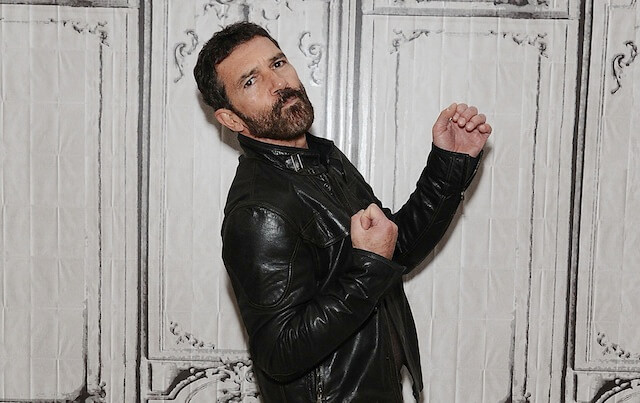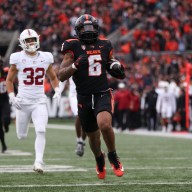Antonio Banderas is surprisingly quiet. Sometimes when he speaks his voice is just below whatever the ambiance is in the room. Every now and then, when properly worked up, the emphatic ham of many of his movies bursts out, before slipping back again. He can get pretty passionate about “The 33,” though, the movie about the 2010 Chilean mining disaster, in which a mine collapse stranded its entire staff miles below the surface for 69 days, a third of that with zero way of contacting the outside world. He plays “Super” Mario Sepulveda, the energetic one who wound up becoming the closest to a de facto leader and the one who appeared the most in the videos made from the mine while they were awaiting their escape. It’s incredible to think you were shooting in real mines.
We were using two different mines. One was more impressive than the other, bigger. The problem there was it was more gassy. There was a lot more methane gas. It was more dangerous, especially if you’re using electricity. It could cause explosions. We started smoking in the mine, until the technicians came up to us and threw a fit. “You f—ers, you smoke one more cigarette, everyone’s out, the entire production is out! You go to Los Angeles to smoke!” It was unbelievably dangerous, since the whole place could just go poof! RELATED: “Brooklyn” is a melodrama deeply felt and deeply smart It’s not the same thing by a close shot, but shooting so long in a real mine must eventually make it easier to get somewhat into the miners’ mindset.
Little by little it started catching up to us mentally. It was uncomfortable — but at the end it pays off. It gave lot of realism to the scenes, because what you see is what it was. It was a beautiful experience, actually, now that I think in retrospect. Tough but beautiful. Everything that is beautiful doesn’t have to be comfortable. This wasn’t a case where you could end a long day in a mine by going back to a swanky hotel and nursing brandy. You were in the middle of nowhere, staying in a nearby, cheap hotel.
It actually worked out perfectly for the movie. We were all pissed off. We were all pissed off at the hotel. The food was horrendous. Not only was it horrendous it was always the same. The exact same thing one day after another — rice with chicken, every single day. Then there were cold showers, and, sometimes, no showers. At 5:30 you’d hear everyone in the hotel screaming and cursing: “Godd—mit! This room is s—! There’s no water!” When we left in the morning it was dark; when we got out of the mine it was dark. Total darkness all the time. [Laughs] But eventually we just had to laugh at it. Did you have much chance to explore Chile apart from the mines?
One night with Juliette Binoche, Gabriel Byrne, the owner of the hotel and three young girls, we drove out two hours into the desert. There was a full moon. It was the most silent moment of my entire life. And the full moon, it was like another planet. You could pure nothingness. Just desert. Magic! The focus in the film isn’t just on the miners but on the attempt on the surface to first find and rescue them. It’s closer to “Apollo 13” or “The Martian” than a film about people suffering before being saved. What we tried to reflect, and which I think is the most anti-Hollywood part of the movie, is that we don’t describe these guys as heroes with no colors. Sometimes they stop being heroes. Don Lucho [the foreman, played by Lou Diamond Phillips] is in shock. He’s paralyzed, he doesn’t know what to do. So Mario takes over, but then he becomes a kind of villain. He forgets about everyone else. Eventually he has to eat all his pride in front of everyone and ask for an apology. We’re trying to say that we all travel through life with the same backpack. That’s important. Otherwise it would just be one color. RELATED: “Miss You Already” takes a very English approach to dying There’s also a fair amount of humor and time spent as they’re joking around, even before they’re found.
When we met the real guys they told us stories down there that were hilarious. When they were about to die they were having a blast. We had to reflect that too, otherwise it would be too heavy. In the dinner scene, we were laughing about the cow. [Ed. There’s a mass fantasy sequence as they consume their last meal before making contact with the outside, with each person imagining their favorite meal. One of them imagines an entire cow showing up.] They had to take the cow in the mine. That was no easy task. The guys that owned the cow, they spent hours pushing this animal to get him down there. This is a film about faith but not in a spiritual way. It shows people believing against the odds that the miners are still alive weeks after they likely would have died.
It’s not a religious film. Faith can be a very practical feeling sometimes. There was faith with the families, who made this irrational push to continue to search for these guys. Given the circumstances, most countries would have called it off early. So faith can pay off.
Antonio Banderas on what it’s like to shoot in a real mine for ‘The 33’

Getty Images
Follow Matt Prigge on Twitter @mattprigge

















